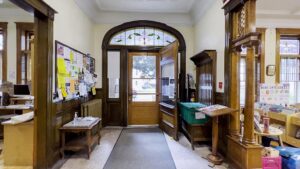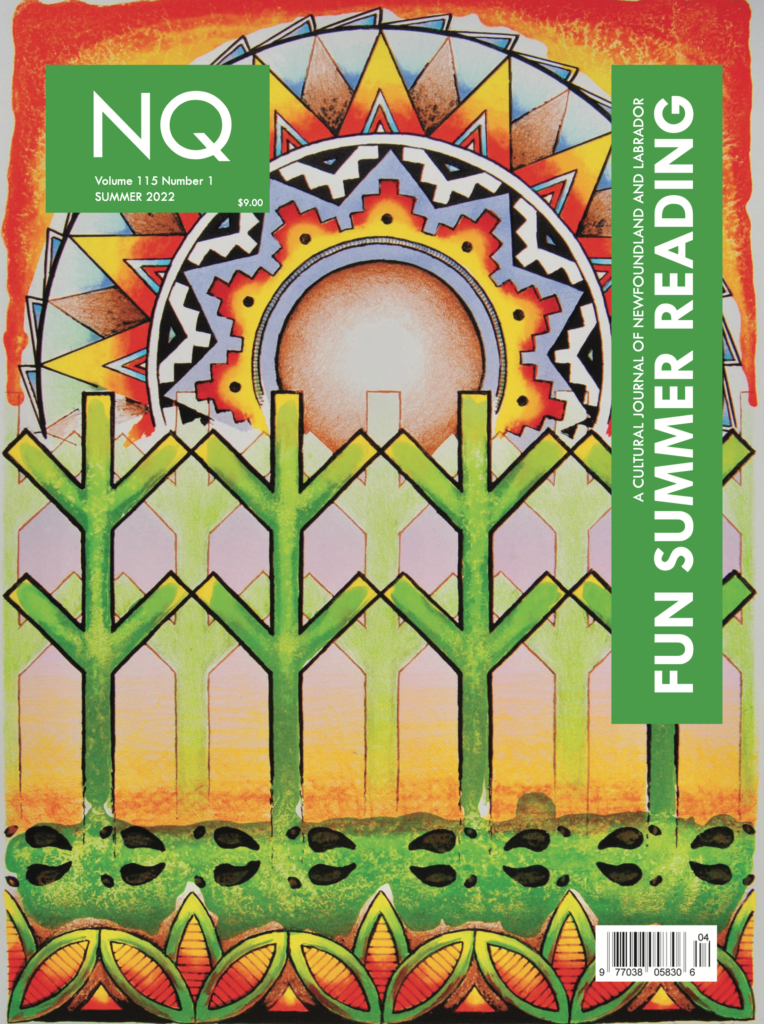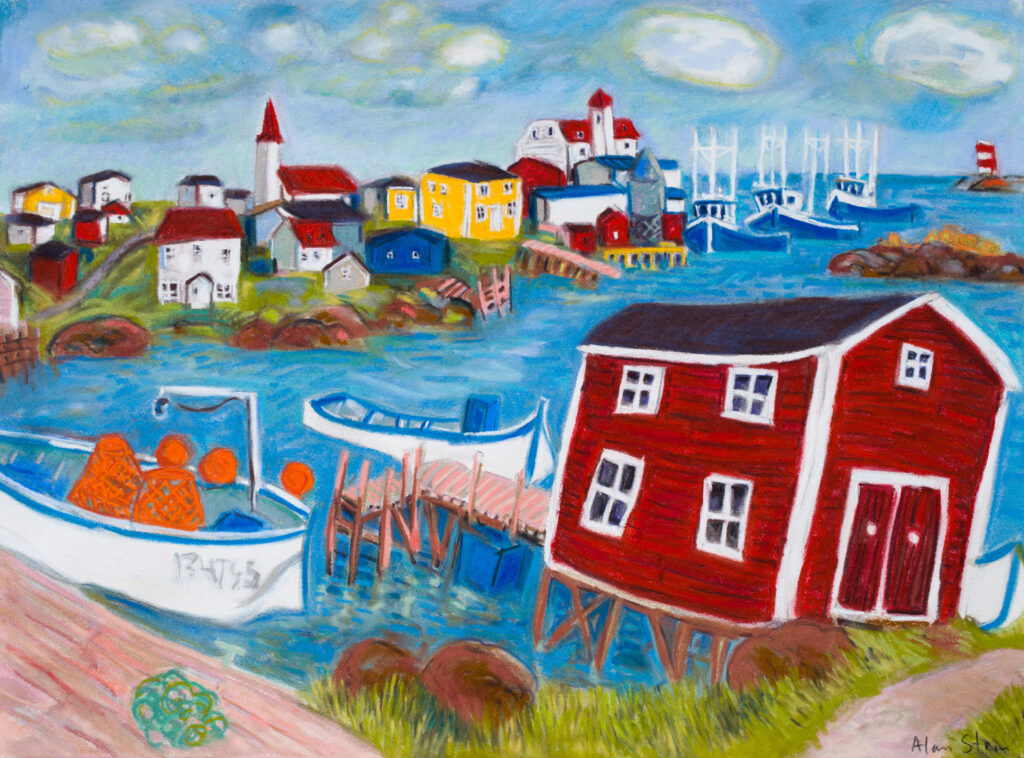Stanstead journey home
March 2025
Earlier this week the Globe and Mail published “A border-straddling library, thrust into the geopolitical crosshairs” by Eric Andrew-Gee , Derby Line VT and Stansted QUE, G&M March 10 2025
It brought to mind this lovely piece by Cynthia Boyd, which originally appeared in last year’s Travel issue, and which we republish here:
On a Saturday morning in late September, I am walking down Mountain View Street in Stanstead, Quebec, where I spent most of my childhood and early youth. Sunlight warms my neck as I haul a cheap carry-on suitcase down the street, heading towards close friends of my parents, Peter and Roberta Boyd, who, like them, taught at Stanstead College, a private school for grades 7 through 12. As the College is honouring my father for 21 years of service as beloved teacher and coach, I have made the journey from St John’s, via Montreal. Dad was overcome by my arrival because it was a surprise. Now, I, too, am overcome as 40 years have come and gone since I left my hometown in my teens when Dad took a new teaching post in New Hampshire.
As I sense wave after wave of nostalgia for ‘moments’ on this street – learning how to ride a bike, serving neighbors from a rickety lemonade stand, chasing fireflies on summer evenings, trick or treating – I am putting one foot in front of the other and breathing in the clear and fragrant fall air.
My noisy suitcase rattles distractingly and I wonder for the first time, if I have woken up any of the residents as I drag it along. I pray people are either heavy sleepers or early risers who will not notice. With each step I am coming closer to my family home of #5 Mountain View – but the “View” has gone, the mountain of Owl’s Head obscured by decades’ worth of ambitious tree planting. What is still there is the same one-storey house I lived in with a quirky L-shaped carport attached at one end. To the right of the carport, there is a little hill heading down into a beautifully mown green space; this is Pope’s field. There has always been a large boulder in the middle which children ran to, in order to avoid being tagged ‘it’ in countless games. I recall rabbits, skunks, and squirrels running about at dusk or dawn, but now it is deer who enjoy cavorting about, and enthusiastically scratch against the knobby edges of the boulder.
I notice a woman’s face looking at me through the kitchen window, and am instantly transported to a time when my mother looked out that same window, while doing the dishes or preparing supper, as she watched me play with our family menagerie: baby tortoise, newt, snake, hamster, tarantula, cat, or dog (in no particular order).
The current owners of the house are Barb and Andy Elliott, recently retired teachers from Stanstead College. Barb and I have corresponded over the intervening years though we have never met in person. She must recognize me from photographs for she beckons me to enter. I look around surreptitiously noticing little changes here and there, but the interior appears so much smaller now than when I was a child.
Barb knows how many wild and domesticated creatures lived in this house from stories she heard from the neighbours. On one occasion, her family were having breakfast when they noticed a large garter snake slithering down the hallway towards the kitchen. It had stopped mid-passage to stretch its long neck and head upwards while its forked tongue flicked in and out tasting the air. “It looked forlorn,” she said “as it sashayed down the hall, perhaps it was hunting for you, Cyndy? Did you leave a snake in this house before you left Stanstead?” In reply, I explain that while my parents were extremely tolerant of various ‘guests,’ they were firm when it came to releasing these creatures sooner rather than later, and preferably before supper!
Though my Dad could not help but encourage both my sister and I to love nature, seeing how he was a biology teacher, my mom also taught us through gardening and crafting. For a short period, my mom worked as an English teacher at Stanstead, but she much preferred younger children. As soon as I turned three, she opened a private daycare in our basement and then later, the basement of the United Church in which she also played the organ and directed the choir. She was also a hard-working president of the PTA for Sunnyside Elementary which both my sister and I attended, along with being a Brownie and Girl Guide leader, in her spare time.
My mother’s volunteerism knew no bounds for during Easter, she hopped in and out of Sunnyside’s classrooms dressed in a full-body rabbit suit she had made, doling out candy. School children in surrounding towns like Beebe and Rock Island were also recipients of her generous spirit. I was completely ignorant of her role as community Easter Bunny until grade two. This is when I noticed a familiar red watch band peeking out from under Easter Bunny’s sleeve.
Sometimes my mother ran out of Easter candy and had to find more quickly. As she was very frugal and knew that the cheapest candy was ‘across the line’ (in Vermont). Mom drove through Stanstead and up the hill into Derby Line where she arrived at the US customs as the Easter Bunny. She had done this before, so the officers knew who she was and laughed as they waved her through. Sometimes the officers came out, large polaroid camera in hand, and took pictures of themselves standing beside her.
In this part of the Eastern Townships, there were once three communities, Stanstead, Rock Island, and Beebe, known as “the Three Villages,” each with its own fascinating history. Today, however, they are all considered the Town of Stanstead.
One feature of what was once “the Three Villages,” has remained relatively constant: the Tomifobia River. Whether I explored it directly, hopped over a smaller version of it with my bike, or looked for minnows alongside its banks, it was an indelible part of my childhood. So too, were a number of historical buildings, such as the Haskell Free Library and Opera House.

As the library was so close to Sunnyside, teachers and children marched there every few weeks; it was, in one sense, a ready-made fieldtrip. Our route took us across a small bridge in what was once Rock Island, over the Tomifobia River. On one particular occasion, the river was moving at great speed as we had had a storm. I remember stopping to gaze down at the mesmerizing tumble and froth of water. I turned to continue walking along the bridge when I tripped and spilled the contents of my school bag. With mounting horror, I watched as my library books slid right through the slats of the bridge and down into the river. I will never forget the sight of them bobbing briefly on the surface and sinking under within a few seconds. Excitedly, a fellow classmate disappeared down a muddy path below the bridge to attempt a rescue. He leaned down and grabbed one soggy book which had lodged itself between rocks near the riverbank.
Once in the Haskell Free Library, I explained in stifled sobs how ‘most’ of my library books had fallen and sunk in the Tomifobia to my teacher and the librarian. The one survivor, which looked remarkably like an accordion, I presented to the librarian. A faintly fishy odor emanated from it as it oozed and pooled river water all over her desk. With one dramatic swish of her hand, the librarian dumped the book into the trash, to my utter astonishment. “It is beyond repair, dear girl,” she said, while writing a little note to my parents, asking them to offer a small donation towards the cost of the “lost” books when next they visited.
As a young teenager, I worked one summer handing out programs for events held in the Opera House, another fascinating feature of the Haskell Free Library. This Opera House stage is elaborately designed with decorative carved columns on either side, and multiple backdrops, including a hand-painted Venetian scene, complete with gondolas.

Deliberately built over the international boundary, blending Queen Anne and Victorian Revival style, and opening in 1904, the Haskell Free Library and Opera House is shared by people living in Stanstead, Quebec, and those in Derby Line, Vermont. The founders were a couple who had dual nationalities themselves: Carlos M Haskell was an American businessman from Derby Line who ran several sawmills. whereas Martha Stewart Haskell was Canadian. The Haskells desired people on each side of the border to enjoy free access, and it has continually attracted the attention of locals and tourists ever since.
Though the facility has two addresses, 1 Church Street in Stanstead and 93 Caswell Avenue in Derby Line, all patrons and visitors must use the US entrance to access the building. Those who come from Canada are allowed to enter the US door without needing to report to Customs, but they must follow a specific route along the sidewalk of Church Street and return to Canada immediately upon leaving the building using the same route. The international boundary is marked by a thick black line beneath the seats of the opera house and diagonally across the centre of the library’s main reading room. The stage and half of the seats are in Canada while the remainder of the Opera Hall lies in the US.
In the main reading room, I can recall my Dad reading a newspaper on the Canadian side while I looked at a large atlas on the American side. Occasionally I would cross over and back for amusement, though this behaviour tried the patience of the librarians, who produced a ‘look’ so terrifying that one was dissuaded from such antics in short order.
While I remember the library’s exterior and interior spaces with fondness, I do not have quite the same affection for the US Customs’ buildings. Reaching for my US passport, I am reminded of how I never carried any kind of identification when I crossed the border as a young girl on many trips with my parents. I realize just how much I took the daily occurrence for granted. In my early teens, however, the US and Canadian Customs did acquire a bit more significance when I began crossing the border on my own. After I finished sixth grade at Sunnyside, my parents decided I would attend Sacred Heart Elementary, for grades seven and eight and then, later, Sacred Heart High School for grades 9 and 10 (before we moved to New Hampshire). Run by sisters associated with the Daughters of Charity of the Sacred Heart, these schools sat high up on a hill overlooking a spectacular view of Lake Champlain in Newport, Vermont.
Along with my Mom and Dad, several other parents formed a bi-weekly carpool system in which they shared driving duties taking us (five) children to and from Newport for school. On average, this took 15 to 20 minutes depending on wait times at the Customs and/or weather conditions. Some parents were better drivers, had cooler cars, or were generally more adept at dealing with teenagers. I am a little biased but my mom was, by far, the funniest parent and the best driver, though our family car could not be defined as cool. We girls often struggled in and out of the backseat of my parents’ two door in our stiff, plaid skirts, part of the school uniform. Like the rest of our carpool companions, my sister and I had more friends in Newport than we did in Stanstead, and I entered into my first romance with Dennis, who happened to be in my eighth-grade class, and lived in Derby Line.
Just a few years before this, my parents had started letting me walk ‘across the line’ on my own. Once I declared myself at Customs, I relished the freedom to buy an ice cream at the fountain shop newsstand for 75 cents. Generally, my Derby Line visits came with errands, as I was often tasked with buying The Boston Globefor my father. During this eighth-grade year, I routinely crossed the border, went through Customs, bought Dad’s paper and an ice cream, and headed to Dennis’s house where he was frequently tinkering with his father’s truck in the front yard.
One Saturday, after calling Dennis on our rotary phone to arrange our morning hang-out, I walked up and over the hill into Derby Line, making my way to Customs. In truth I was already ‘across the line,’ but I still had to go through Customs. I could see Dennis about to wash his father’s truck, literally about 200 feet to my left. He smiled and shouted, “See you after Customs!” At that moment, I felt a streak of rebelliousness. This whole Customs’ thing was so foolish: Dennis was right over there. What would it matter if I ditched Customs and veered left? Surely, the officials would not care. Thinking back on this, I wonder at my foolishness: What was I thinking? Did I not know there were security cameras placed in strategic locations all around?
Recklessly, I turned left and walked the one-minute journey directly across the road to Dennis’s house. He was dipping a sponge into a bucket of soapy water when he noticed me crossing the road, and he stopped, sponge dripping all over his pants and shoes, and mouthed the words, “What are you doing?” As I laughingly reassured him that no one gives two cents about a Canadian girl who skips Customs, a US Customs’ vehicle suddenly appeared, alarm blaring, and pulled right up on the curb. Two officers opened car doors simultaneously, then curtly asked me to accompany them to Customs to declare myself at the border. This sounds straightforward, and I did go willingly, but the officers had also called my parents, who appeared minutes after I was ‘done’ explaining my behaviour to the officers. Not surprisingly, my lone forays into Derby Line were curtailed, but Dennis crossed the line regularly. In fact, his border crossings were so frequent on Saturdays that the Customs’ officers on both sides began teasing: “When’s the wedding?!”
It was at the end of a soft and gentle summer that I left my childhood home, and the Town of Stanstead well known for its location on the Canada-United States border across from Derby Line, Vermont. At the age of 16, I did feel the loss acutely, no less so than my parents and my sister, Laura, who was four years older. Following the arrival and subsequent packing and removal of the contents of our house by a moving company, my family and I were hugged and kissed by friends, neighbours, and Stanstead College colleagues who had gathered to say farewell. My sister is still haunted by the memory of this moment for we never should have left her behind with her best friend’s family, even if she was slated to attend Bishop’s University in September.
Cynthia Boyd is a folklorist and part-time lecturer at Memorial University, writer, researcher, flower and herb gardener, and keen defender of wild creatures, especially birds, mice, moths, spiders, and earwigs.



